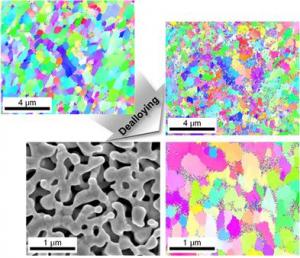Engineering Black Gold, as Light as the Bones of Birds

A research team developed the nanoporous structure after strengthening with ball milling technique and producing silver only with dealloying technique. Copyright : UNIST
A team of Korean research team led by Professor Ju-Young Kim (School of Materials Science and Engineering) of Ulsan National Institute of Science and Technology (UNIST), South Korea, has recently announced that they have successfully developed a way to fabricate an ultralight, high-dense nanoporous gold (np-Au).
In a new paper, published in Nano Letters on March 22, the team reported that this newly developed material, which they have dubbed “Black Gold” is twice more solid and 30% lighter than standard gold.
According to Prof. Kim, “This particular nanoporous gold sample has a 100,000 times wider surface when compared to standard gold. Moreover, due to its chemically stablity, it is also harmless to humans.”
The surfaces of np-Au are rough and the metal loses its shine and eventually turns black when they are at sizes less than 100 nanometres (nm). This is the reason that they are called “Black Gold”.
In their study, the team investigated grain boundaries in nanocrystalline np-Au and found a way to overcome the weakening mechanisms of this material, thereby suggesting its usefulness.
The team used a ball milling technique to increase the flexural strength of the three gold-silver precursor alloys. Then, using free corrosion dealloying of silver from gold-silver alloys, they were able to achieve the nanoporous surface. According to the team, “The size of the pores can be controlled by the temperature and concentration of nitrate.” Moreover, they also note that this crack-free nanoporous gold samples are reported to exhibit excellent durability in three-point bending tests.
Prof. Kim's team notes, “Ball-milled np-Au has a much greater density of two-dimensional defects than annealed and prestrained np-Au, where intergranular fracture is preferred.” They continue, “Therefore, the probable existence of grain boundary opening in the highest tensile region is attributed to the flexural strength of np-Au.”
They suggest that this newly developed technique can be also applied to many other metal, as the np-Au produced by this technique have shown increased strength and durability while still maintaining the good qualities of standard gold.
This means that this technique can be also used in other technologies, like catalytic-converting as observed by platinum, the automobile catalyst and palladium, the hydrogen sensor catalyst.
Journal Reference:
Eun-Ji Gwak and Ju-Young Kim. “Weakened Flexural Strength of Nanocrystalline Nanoporous Gold by Grain Refinement”. Nano Lett., (2016).
Associated links
Journal information
Nano Letters
Funding information
National Research Foundation of Korea (NRF), Korean Ministry of Science, ICT & Future Planning (MSIP), KIST-UNIST partnership program
Media Contact
More Information:
http://www.researchsea.comAll latest news from the category: Materials Sciences
Materials management deals with the research, development, manufacturing and processing of raw and industrial materials. Key aspects here are biological and medical issues, which play an increasingly important role in this field.
innovations-report offers in-depth articles related to the development and application of materials and the structure and properties of new materials.
Newest articles

Trotting robots reveal emergence of animal gait transitions
A four-legged robot trained with machine learning by EPFL researchers has learned to avoid falls by spontaneously switching between walking, trotting, and pronking – a milestone for roboticists as well…

Innovation promises to prevent power pole-top fires
Engineers in Australia have found a new way to make power-pole insulators resistant to fire and electrical sparking, promising to prevent dangerous pole-top fires and reduce blackouts. Pole-top fires pose…

Possible alternative to antibiotics produced by bacteria
Antibacterial substance from staphylococci discovered with new mechanism of action against natural competitors. Many bacteria produce substances to gain an advantage over competitors in their highly competitive natural environment. Researchers…





















